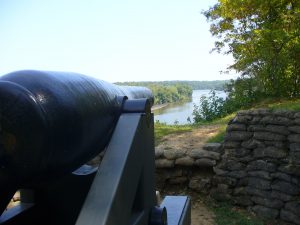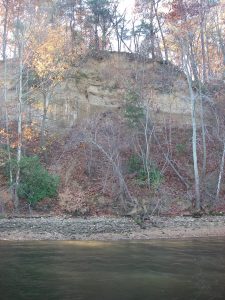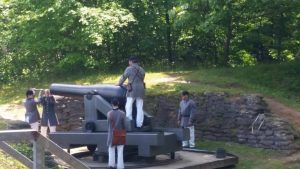Forts — Drewry’s Bluff: Tourism on the Front Lines
 On St. Patrick’s Day, 1862, soldiers began construction of fortifications at Drewry’s Bluff, overlooking the James River about eight miles south of Richmond. This location was a key spot in defending Richmond by water. Drewry’s Bluff was not only a fort but became a tourist attraction, and it reflects the early ideas of war and internal debates about patriotism.
On St. Patrick’s Day, 1862, soldiers began construction of fortifications at Drewry’s Bluff, overlooking the James River about eight miles south of Richmond. This location was a key spot in defending Richmond by water. Drewry’s Bluff was not only a fort but became a tourist attraction, and it reflects the early ideas of war and internal debates about patriotism.

Ninety feet above the James River, by May, 1862 the fort mounted about eight large artillery pieces. At a bend in the river with a clear view of the water, any passing ship had to pass under its guns. The test came on May 15, 1862 when five Union warships, including the Monitor, attempted to pass and capture Richmond. After a four-hour battle, the ships withdrew.
The battle itself is worthy of study, but there is so much more to the Drewry’s Bluff story. The site became an important post, home to the Southside Artillery, infantry soldiers, a Naval Academy, and a Marine Corps Camp of Instruction- thus hosting all branches of the Confederate military. A village with support facilities sprung up, and soon excursion cruises brought curious civilians to see the fort.

One newspaper ad noted, “The steamer SCHULTZ . . . leaves for Drewry’s Bluff, THIS DAY, at 12 o’clock, returning at half-past 2 o’clock. Fare for the round trip, one dollar.” Another advertised ships going to the “Drewry’s Bluff Pic-Nic Grounds.” A final example states, “Drewry’s Bluff is now open (exclusively for this steamer) as an excursion resort and pic-nic grounds, and excursionists can stop off there and take the Germ’s last trip back to Richmond . . Music and refreshments. Emerson Upright Grand Piano . . .Fare to Drewry’s Bluff: Round trip 25 cents. No charge for children under five years. No improper persons allowed aboard.”
In July, 1863 the Richmond Sentinel noted that “This Gibraltar is growing rapidly to be quite a village. In addition to the soldiers quarters, neat log-houses have been erected for their families and the refugee ladies and children from Norfolk and Portsmouth. A hotel has been established and is doing a good business, a post-office is also in operation, with mail facilities with Richmond twice a day. It also contains a very neat chapel . . . Another attractive feature is the splendid market garden, cultivated by the soldiers, which furnished them an abundance of excellent vegetables.”
Officer Charles Blackford noted “All of the soldiers’ huts are built in the style of the cottages at a fair ground and very pretty ornamented, and the men are making little gardens . . .” Midshipman John Scharf recalled the daily routine: “The morning gun was fired at 7 o’clock and at 8 a breakfast of hard tack . . and sweet potatoes or beans . . .Sick call, studies, and recitations occupied the hours until 2 o’clock, and then came a dinner . . . . School exercises and dress parade took up the remainder of the afternoon, and the day ended with tattoo at 9:30 and taps at 10.” Another Midshipman, William Clayton, noted it had become “a regular picnic ground for the young people of Richmond and Petersburg, which we middies greatly enjoyed.” Midshipman James Morgan wrote of “parties composed of ladies and gentlemen would frequently visit the Bluff and they made it quite gay.”
In the summer of 1863 one excursion brought 700 people, along with a brass band, and featured dancing on board. The upper-class Cary cousins, along with other Richmond socialites also ventured to Drewry’s Bluff, eating strawberries and ice cream, walking all around the fort. Constance Cary Harrison wrote that she visited, and “all the people who make up gay society” went, including Varina Davis and Angela Mallory (wife of the Secretary of the Navy). Mary Chestnut recorded in her diary, “Drewry’s was the place I wished to see. Our Gibraltar” President Davis and Varina visited together in November 1863
The visitation brought up issues of appropriateness in wartime, as well as security, the Union navy could re appear anytime. Richmond refugee and hospital worker Judith McGuire wrote, “Some people here seem crazed with gayety, in the midst of wounded and dying, the low state of the commissariat, the anxiety of the whole country, troubles of every kind by which we are surrounded, I am mortified there are gay parties . . .”
Chimborazo Hospital worker Phoebe Pember agreed, saying, “If Spartan austerity is to win our independence, we are a lost nation.”

Aside from the moral issues, of primary concern to commander Captain Sydney Smith Lee (whose brother took command of the Army of Northern Virginia in 1862) was the issue of security. Later in 1863 Lee protested against the excursions, which sometimes brought “lewd women and whiskey” to the fort, and the danger of “demoralization among our soldiers.” He said, “It is adjured at no time, when an attack from the enemy may occur any day, for all sorts of people to be poking about the batteries Visitors are now confined until further order, to person having business there.”
Tourism flourished at this post on the front line, and war was not seen for the danger it was, even in 1863 after much death and destruction. Visitation by curious and party-going civilians ended, and the fort remained an important base and training center until evacuated on April 3, 1865.
An infantryman’s account of the May 15, 1862 naval action at Drewry’s Bluff is in “The Petersburg Regiment in the Civil War: A History of the 12th Virginia Infantry from John Brown’s Hanging to Appomattox, 1859-1865” (Savas Beatie, 2019), at pages 45-47. The book won the 2019 Distinguished Writing Award in Unit History from the Army Historical Foundation.
Let’s hear it for lewd women and whiskey!